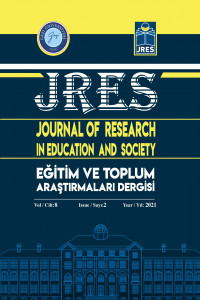SANAT, SANATÇI VE ÜSTBİLİŞ İLİŞKİSİ
Araştırmada sanat ve sanatçı ile biliş ve üstbiliş ilişkisi incelenmiştir. Sanat eğitiminin bilişsel bir etkinlik olduğu vurgulanarak, sanat eğitiminin üstbiliş kavramı ve üstbilişsel stratejilerle ilişkisi açıklanmıştır. Geçmişten bugüne sanatın bilişsel boyutuyla ilgili gelişmeler ele alınmıştır. Birçok teorisyenin sanatın bilişselliğine yönelik açıklamaları ile araştırma desteklenmiştir. Araştırma literatür taranarak oluşturulmuştur. Üstbiliş stratejileri incelendiğinde sanatçıların geliştirdikleri stratejilerle benzerlik gösterdiği tespit edilmiş hem de üstbilişsel stratejilerin sanat eğitiminde bilinçli bir şekilde kullanılmasına dönük öneriler sunulmuştur. Yapılan bu araştırma ile literatüre katkı sağlanılmaya çalışılmıştır
Anahtar Kelimeler:
Sanat, sanat eğitimi, görsel sanatlar, üstbiliş, üstbilişsel strateji
THE RELATIONSHIP OF ART, ARTIST AND METACOGNITION
The relationship of art, artist and cognition, metacognition is explained in this paper. This research is focused on cognitive dimension of art education from past to present. Furthermore, it is supported by theorists who stressed cognitive dimension of art education. The research is composed by literature review. It is obvious that there are limited research about the cognitive dimension of artistic process and relationship of art education and metacognition. The purpose of this study is to point out the importance of the relationship of art education and metacognition based on the hypothesis that art education is a cognitive activity. There is a similarity between artists strategies and metacognitive strategies. It is important to have metacognitive awareness that student may learn successfully. Metacognitive strategies is also may have an essential role to increase academic achievement of art education students. In this sense, as a recommendation metacognitive strategies can be integrated into art education curriculum. Generally, the paper tries to contribute the literature on the issue of art education and metacognition
Keywords:
Art education, visual arts, metacognition, metacognitive strategy,
___
- Buyurgan, S. , Buyurgan, U. (2012). Sanat eğitimi ve öğretimi. (3. Baskı). Ankara: Pegem Akademi.
- Cameron, F. D. (1995). Aesthetic perception, metacognition and transfer thinking in the visual arts. Yayınlanmamış Doktora Tezi, University of California, Los Angeles.
- Çakıroğlu, A. (2007). Üstbiliş strateji kullanımının okuduğunu anlama düzeyi düşük öğrencilerde erişi artırımına etkisi. Yayımlanmamış Doktora Tezi, Gazi Üniversitesi Eğitim Bilimleri Enstitüsü, Ankara.
- Davis, J. H. (2000). Metacognition and multiplicity: The arts as models and agents. Educational Psychology Review, 3(12), 340-359.
- Efland, A. D. (2002). Art and cognition. New York : Teachers College Press.
- Efland, A. (2004). The arts and the creation of mind: eisner's contributions to the arts in education. The Journal of Aesthetic Education, 38(4), 71-80.
- Eisner, E.W. (1967). Changing Conceptions of Artistic Learning. The Elementary School Journal, 68(1), 18-25.
- Eisner, E.W. (1987). The Role of Discipline-Based Art Education in America's Schools. Art Education, 40(5), 6-26.
- Flavell, J. (1979) Metacognition and cognitive monitoring: a new area of cognitive- developmental inquiry. American Psychologist, 34(10), 906-911.
- Gardner, H. (1983). Artistic intelligences. Art Education, 36(2), 47-49.
- Goldberg, P. D. (2005). Metacognition and art production as problem solving: a study of third grade. Visual Arts Research, 2(31), 67-75.
- Miller, T. , & Geraci, L. (2011). Training metacognition in the classroom: the influence of
- incentives and feedback on exam predictions.
- Metacognition Learning, 6, 303-314.
- Parsons, M. (2002). The role of the visual arts in the growth of mind. Studies in Art Education A Journal of Issues and Research, 46 (5), 369-377.
- Parson, M. J. (1998). İntegrated curriculum and our paradigm of cognition in the arts. Studies in Art Education, 39(2), 103-116.
- Pintrich, P. R, (2002). The role of metacognitive knowledge in learning, Teaching and assessing. Theory into Practice. 4(41), 219-225.
- Rezvan, S., Ahmadi, S. A., Abedi, M. R.(2006) The effects of metacognitive training on the academic achievement and happiness of Esfahan University conditional students.
- Counselling Psychology Quarterly. 4(19), 415-428.
- Sapancı, M. (2010). Güzel sanatlar eğitimi ögrencilerinin bilişüstü farkındalık düzeyleri ve öğretmenlik mesleğine yönelik öz-yeterlik inançlarinin incelenmesi. Yayımlanmamış Yüksek Lisans Tezi, Abant İzzet Baysal Üniversitesi Sosyal Bilimler Enstitüsü, Bolu.
- Schraw, G. , & Dennison, R. S. , (1994). Assessing Metacognitive Awareness. Contemporary Educational Psychology, 19 (4), 460-475.
- Schraw, G. , & Moshman, D. (1995). Educational Psychology Review. 7(4), 351-371.
- Schraw, G. (1998). Promoting general metacognitive awareness. Instructional Science. 26(1-2), 113-125.
- Schraw, G. (2002). Metacognition in learning and ınstruction theory, research and practise. H.J. Hartman (Ed.), General metacognitive awareness. Second Edition. (ss. 3-16). USA.
- Shin, S. R. (2005). A metacognitive art criticism module accessed by high school students using an interactive CD-Rom. Visual Arts Research, 1(31), 63-75.
- Smalser, A. G. (1991). Metacognition and rhe art-making process of visual arts. Yayımlanmamış Doktora Tezi. The State University of New Jersey Graduate Program in Creative Arts Education, New Jersey.
- Solso, R. L. (1994). Cognition and the visual arts. Cambridge, Massachusetts: The MIT
- Press. Vukman, K. B. (2012). Metacognitive accuracy and learning to learn: a
- developmental perspective. Problems of Education in The 21st Century, 15(46), 1822-7863.
- Yayın Aralığı: Yılda 2 Sayı
- Başlangıç: 2014
- Yayıncı: Gazi Üniversitesi
Sayıdaki Diğer Makaleler
YAŞANILAN TARİHSEL MEKÂNIN ÖĞRENCİLERİN TARİH BİLİNCİ İLE İLİŞKİSİ (GAZİANTEP İLİ ÖRNEĞİ)
Necdet HAYTA, Ş. Gülin KARABAĞ, Selim YUMAK
SINIF ÖĞRETMENİ ADAYLARININ YARATICI DRAMAYA YÖNELİK TUTUMLARININ İNCELENMESİ
LİTERATÜR TEMELLİ BİR ARAŞTIRMA: TÜRKÇE ÖĞRETİMİNİN SORUNLARI
Yusuf CANBOLAT, M. Çağatay ÖZDEMİR
Hazel ERCAN, Şebnem YILDIRIM ORHAN
ÇOCUKLARIN TÜKETİM ALGISININ RESİMLERE YANSIMALARI
ERKEN CUMHURİYET DÖNEMİNDE YABANCI UZMAN RAPORLARINA GÖRE TÜRK EĞİTİM SİSTEMİNİN EZBERCİLİK SORUNU
TÜRKİYE CUMHURİYETİ EĞİTİM POLİTİKALARI
SANAT, SANATÇI VE ÜSTBİLİŞ İLİŞKİSİ
HANGİ YÖNLERİMİZ EKSİK? HİZMET ÖNCESİ İNGİLİZCE ÖĞRETMENLERİNİN GÖRÜŞLERİ
